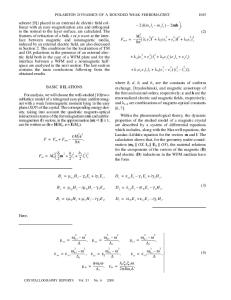Thermal expansion of nano–boron carbide under constant DC electric field: An in situ energy dispersive X-ray diffraction
- PDF / 618,807 Bytes
- 8 Pages / 584.957 x 782.986 pts Page_size
- 15 Downloads / 957 Views
Thermal expansion of nano–boron carbide under constant DC electric field: An in situ energy dispersive X-ray diffraction study using a synchrotron probe _ Hülya Biçer1,a), Enver Koray Akdoğan2, Ilyas Şavklıyıldız3, Christopher Haines4, 5 2 Zhong Zhong , Thomas Tsakalakos 1 Department of Metallurgy and Materials Engineering, Kütahya Dumlupınar University, Kütahya 43000, Turkey; and Department of Materials Science & Engineering, Rutgers University, Piscataway, New Jersey 08904, USA 2 Department of Materials Science & Engineering, Rutgers University, Piscataway, New Jersey 08904, USA 3 Deparment of Metallurgy and Materials Engineering, Konya Technical University, Konya 42250 Turkey 4 US Army Research Laboratory, Aberdeen Proving Ground, Adelphi, Maryland 21005, USA 5 National Synchrotron Light Source I & II, Brookhaven National Laboratory, Upton, New York 11973, USA a) Address all correspondence to this author. e-mail: [email protected]
Received: 12 September 2019; accepted: 25 November 2019
The thermal expansion coefficient (TEC) of nano-B4C having 50 nm mean particle size was measured as a function of applied direct current (DC) electric field strength varying from 0 to 12.7 V/mm and over a temperature range from 298 K up to 1273 K. The TEC exhibits a linear variation with temperature despite being measured over a range that is well below 50% of B4C’s normal melting temperature. The zeroth- and first-order TEC coefficients under zero-field condition are 4.8220 ± 0.009 × 10−6 K−1 and 1.462 ± 0.004 × 10−9 K−1, respectively. Both TECs exhibit applied DC electric field dependence. The higher the applied field strength, the steeper the linear thermal expansion response in nano-B4C, which suggests that the applied field affects the curvature of the interatomic potentials at the equilibrium bond length at a given temperature. No anisotropic thermal expansion with and without applied electric field was observed, although nano-B4C has a rhombohedral unit cell symmetry. The rhombohedral unit cell angle was determined as dR = 65.7046° (0.0007), and it remains unaffected by a change in temperature and applied electric field strength, which we attribute to B4C nanoparticle size and its carbon saturation.
Introduction Thermal expansion is an important anharmonic solid-state property of materials [1, 2]. It is of particular importance for high temperature structural and mechanical applications where high thermal stability and high strength are required in a given engineering material for which the (stress-free) thermal strains need to be controlled. Fundamentally, the magnitude of the thermal expansion coefficient (TEC) is inversely related to the stiffness of the chemical bonds forming the solid of interest [1, 2]. Boron carbide (B4C hereafter) is a highly covalent, nonoxide ceramic that has a high melting temperature (2763 °C at 1 atm), outstanding hardness (2400–2800 on Vickers scale), high neutron absorption cross section (760 barn at neutron velocity of 2200 m/s), and low density (3.15 g/cm3) [3, 4, 5, 6, 7].
ª Materials Researc
Data Loading...











